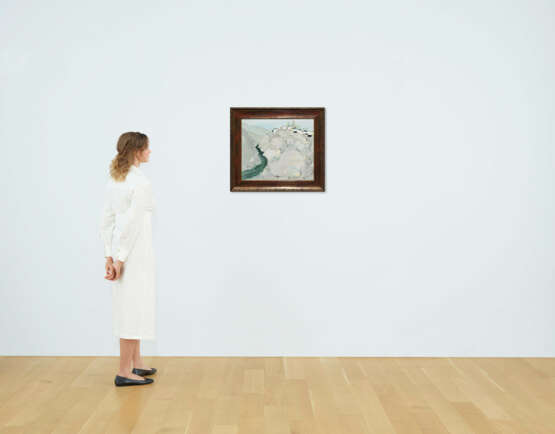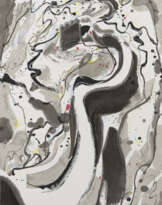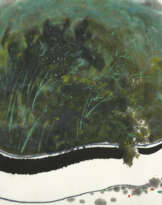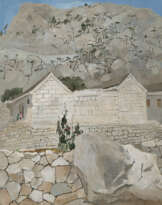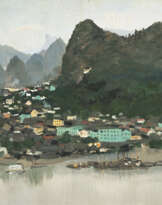ID 965879
Lot 215 | WU GUANZHONG (1919-2010)
Valeur estimée
HKD 4 500 000 – 6 500 000
Households Alongside the Wu River
signed and dated in Chinese (lower left)
oil on canvas
45.8 x 53 cm. (18 x 20 7/8 in.)
WU GUANZHONG
Painted in 1985
Provenance
Sotheby’s Hong Kong, 30 October 1998, lot 40
Acquired at the above sale by the present owner
Literature
Hunan Fine Arts Publishing House, The Complete Works of Wu Guanzhong Vol.III, Changsha, 2007 (illustrated, p. 217).
Post lot text
“Rock formations have inspired a range of artistic expressions with their order, movement, declivity, spontaneity, moderation…”
------ Wu Guanzhong
In 1984, Wu Guanzhong journeyed along the Three Gorges and through the Kuimen Gate to Fuling and further up along the Wu River before finally arriving at Gongtan, a hidden ancient town located at the top of Mount Fenghuang. There, the artist devoted himself to painting while listening to the sound of waves for half a month, which saw the birth of such iconic masterpieces as Households Alongside the Wu River.
In a panoramic view, Households Alongside the Wu River presents the subliminal scenery of the eponymous site. What is remarkable about this work is its flattered perspective that encourages the viewer to take on a visual journey with the painter. Along this river, one can marvel at the variegated forms in nature rendered by the artist using a palette knife as well as the almost stereoscopically voluminous boulders in loose and dynamic brushstrokes. The landscape is depicted in subdued greyish tone. This subtle approach to the overall mood is key to creating the atmospheric effect that defines the work, which in turn evokes the aesthetic ideals from the Chinese landscape traditions. Situated at the top of the mountain is Gongtan, where one seems to hear the sound of the simple lives lived in this ancient town. The trees of varying heights between the households are also a delightful feature reminiscent of the abstract paintings by Gerhard Richter for whom the paint on canvas is the trace of movement and vitality. Through his bravura control of the brush, Wu Guanzhong has turned his intense passion for re-connecting with nature into motifs of this emotion-laden landscape painting. It is for this reason that this work now stands as a testimony to his artistic excellence and belief in his own vision.
A pioneer in every sense of the word, Wu Guanzhong brought about a new tradition of depicting Chinese landscape using Western mediums. Before starting to paint, the artist would first take a careful look from the foot of the mountain before climbing up to the summit to look back down at the surrounding majestic view. This process allowed him to incorporate the various angles of the same view into one coherent pictorial plane. For him, dots, lines, and planes are the fundamental tools to build landscape. Coloured dots breathe life into the trees and figures; lines are used to delineate mountain forms while splashed ink and broad strokes illustrate the Wu river; finally, planes of different colours are pieced together to add volume to the boulders. The result is a dramatic landscape filled with energy and joy. Indeed, if one looks closely at the painting details, one cannot help but be amazed by the delicate brushwork features that are rarely seen in his other paintings. Examples include the mountains rendered using a palette knife to bring out their volume and the river in an intense green to accentuate its depth. In fact, Households Alongside the Wu River departs from the artist’s other landscape paintings with its greyish and off-white tone that gives the scene a soothing quality, as if enveloped in a soft mist. Overall, the evidently loose and free brushstrokes deriving from Chinese and Western aesthetics have come together to transform the artist’s emotions arising from his travel into the tangible forms expressed in this highly personal landscape. In every respect, this painting is an outstanding achievement that alludes to the highest philosophical ideal where the universe and humans become one. Today, a special memorial museum dedicated to the oil paintings of the Wu River by Wu Guanzhong stands in Gongtan, attesting to the artist’s unquestionable significance in the development of art inspired by the region.
Wu Guanzhong devoted his entire life to modernising the genre of guohua, or national painting, and to incorporating the medium of oil into this larger development. In this respect, Households Alongside the Wu River distinguishes itself as a peerless masterpiece that witnesses the amalgamation of the Chinese and Western pictorial traditions. It also encapsulates the value of an important moment when the artist accidentally stumbled upon this hidden village during his journey. Indeed, the history-making appearance of this painting for the first time in the market has allowed us to catch a glimpse of this pivotal point in his long career. In the 1970s, while anchored by the medium of oil, the artist also started a series of attempts in ink. Such cross-pollination of mediums once again demonstrates the transcendence of his approach over cultural barriers. It can thus be said that Wu Guanzhong painted not only the landscape along the Wu River as he saw it, but also his own life devoted to his motherland and its people.
| Artiste: | Wu Guanzhong (1919 - 2010) |
|---|---|
| Technique appliquée: | Huile sur toile |
| Style artistique: | Art moderne |
| Lieu d'origine: | Chine, Asie de l'Est, Asie |
| Catégorie maison de vente aux enchères: | Peintures |
| Artiste: | Wu Guanzhong (1919 - 2010) |
|---|---|
| Technique appliquée: | Huile sur toile |
| Style artistique: | Art moderne |
| Lieu d'origine: | Chine, Asie de l'Est, Asie |
| Catégorie maison de vente aux enchères: | Peintures |
| Adresse de l'enchère |
CHRISTIE'S 18 Chater Road Central Hong Kong Hong Kong | ||||||||||||||
|---|---|---|---|---|---|---|---|---|---|---|---|---|---|---|---|
| Aperçu |
| ||||||||||||||
| Téléphone | +85227601766 | ||||||||||||||
| Fax | +852 2760 1767 | ||||||||||||||
| Conditions d'utilisation | Conditions d'utilisation | ||||||||||||||
| Heures d'ouverture | Heures d'ouverture
|

